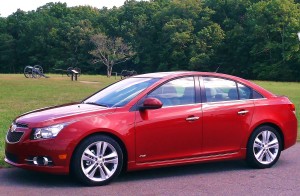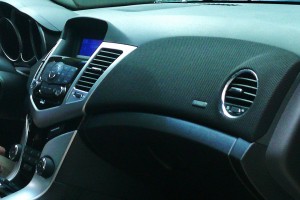Cruze helps Chevy gain small-car focus
By John Gilbert
WASHINGTON, D.C. — The new Chevrolet Cruze made its official media introduction in and around Washington, D.C., and rural Virginia — a setting filled with history and imagery that rivaled the vehicle itself as an attraction. We drove up to the Manassas battlefield, where the bloodiest of Civil War battles occured, and past Bull Run and other historic sites in the Virginia countryside. Until you visit those places, the U.S. capitol emerging in Washington, D.C., while the Confederate capitol was in Richmond, Va., was among obscure memories from high school history class. Visiting them, and their proximity, adds perspective to it all.
That scene plays out as the historical impact of Chevrolet seeking to enliven the second have of its hope to be known as the “once and future” vanguard of the U.S. auto industry, because the Cruze is the vehicle that could prove Chevrolet can, indeed, build an outstanding compact car.
Chevrolet small-car marketing director Margared Brooks told the assembled auto-writers: “We have to bring out cars the people want.”
My personal imagery gong sounded immediately, loud and clear, because during those decades when General Motors made ever-larger and ever-more profitable cars and SUVs, journalists might ask about the social or environment responsibility of building excessively large vehicles with excessively low fuel economy. Every time, a GM executive would shrug and say: “We’re only making the vehicles that the people want.”
We will write off the familiar rhetoric as unfortunate coincidence, because this time it seems that Chevy folks might mean it, and they might finally have caught on to what dozens of warning signs had tried to indicate over the last two decades.
With the Cruze, Chevrolet has something that fulfills U.S. drivers’ wants and needs, and also could represent a large turnabout for responsibility. In the past, GM, and particularly Chevrolet, had such a hold on the industry that U.S. car-buyers would “want” anything Chevy was going to build. But over the last three years, GM has undergone the turmoil of nearly sinking when high fuel costs signalled the abrupt end of large-truck and car sales, which was followed swiftly by bankruptcy, the well-publicized government bailout loans, and only now the apparent righting of the sinking corporate ship.
The Cruze is capable of leaving those cynical memories behind. It is a compact car aimed at challenging the Honda Civic, Toyota Corolla, Volkswagen Golf, Ford Focus, and Hyundai Elantra in a highly competitive downsized market where Chevrolet has been just a token performer. There was the Cavalier, of course, and more recently the Cobalt. Remember, in fact, a few months ago, when football analyst Howie Long exchanged his integrity for a pile of Chevy advertising money, and he’d come on television to announce that the 2010 Cobalt was “better than” the Honda Civic? Howie didn’t tell us that the Cobalt was so good, GM was about to eliminate it for 2011.
The Cruze not only replaces the Cobalt with a slightly larger and more technically advanced car, but from its appearance, ride, handling, and performance standpoints, the Cruze seems to be on-target to be the best small car Chevrolet has ever offered to the public.
A few years ago, when the Saturn Aura was introduced, I suggested it might be the best sedan in the entire GM stable. There was a reason for that. The Aura was a revised version of the four-year-old Opel Vectra from GM’s arm in Germany. A year later, the Malibu was another version of the Vectra/Aura. Then GM blessed Saturn with the Astra, which was a rebadged version of the Opel Astra, and I wrote that car was the best small car GM had ever offered. As GM chose to eliminate Saturn and Pontiac from the scene, Opel had redesigned the Vectra into a new car called the Insignia. With Saturn gone, GM gave the new version of the Insignia to Buick as the 2011 Buick Regal.
Opel, meanwhile, totally revised the Astra two years ago, and it won 2010 European Car of the Year awards. That car and the Cruze share the same platform, with the Astra being a hatchback and the Cruze getting what Chevrolet calls “more expressive” styling. For power it has either a 1.8-liter 4-cylinder in the base LS, or a 1.4-liter turbocharged engine, standard in the LT1, LT2, LTZ, and Eco models. With either a 6-speed manual or a 6-speed automatic, the 1.4 turbo produces 138 horsepower and 148 foot-pounds of torque.
Driving the Cruze is impressive, with its flat and stable attitude in turns, and power that might best be described as adequate. Chevrolet says the Cruze accelerates 0-60 in 10.0 seconds, while the Civic does it in 8.6 and the Corolla in 9.4. It feels composed and coordinated, though, and I prefered the more basic interior styling, with a 2LT model having a coarse woven fabric on the dashboard and for accents.
“The trend is moving away from larger to smaller vehicles,” Our Ms. Brooks said. “Two or three years ago, selling small vehicles was an uphill climb, but in 2008, the spiked fuel prices triggered the move to smaller vehicles. But customers still want upscale smaller cars. If a vehicle is high-styled and more fuel-efficient, customers are much more likely to consider it.”
The design of the Cruze is smooth and contemporary. “It has an exterior to fall in love with, and an interior to live with,” said Michael Simcoe, executive director of Chevrolet design. Among the interior refinements are a contemporary instrument layout, with piano-black and silver trim, a Pioneer 9-speaker audio system, all the Bluetooth and USB connectivity you might want, and even a navigation screen. A nav screen is not to be trifled with. When the Malibu came out and won Car of the Year honors, you could not get a nav screen in the car, but only OnStar’s “turn-by-turn” nav lady telling you where to go. So to speak. There are also safety amenities, such as standard StabiliTrak, traction control and antilock brakes, and inside, there are 10 standard airbags, including front seat side, head-curtain, knee and outboard rear side bags.
Interior volume of the 4-door sedan Cruze shows 94.6 cubic feet of volume, compared to 92.0 for the Corolla and 90.9 for the Civic, and cargo capacity of 15.4 in the Cruze, better than the 12.3 cubic feet in the Corolla, or 12.0 in the Civic. The suspension is excellent, with MacPherson strut front and a Z-link rear with a torsion beam, set up for side-to-side wheel control, making the Cruze handle well enough to potentially handle the competition. The basic Cruze comes with 16-inch wheels and a Touring suspension, with disc front and drum rear brakes. The Sport suspension option adds 17-inch wheels and 4-wheel discs, while the top LTZ has Sport suspension standard and 18-inch wheels. The Sport suspension in the LTZ has higher spring rates than the outgoing Cobalt SS, which is reflected by the car’s superior stability and firmness.
The power, however, is another matter. And the never-ending compromise blending power and fuel economy is the larger part of that question. The 1.8 non-turbo has 138 horsepower and 123 foot-pounds of torque, while the 1.4 turbo has the same 138 horses at 4,900 RPMs, and much stronger 148 foot-pounds of torque which rise to a peak at 1,850 RPMs and holds that peak to 5,000 revs. That engine is part of the recharging system for the upcoming plug-in electric Volt. Its high-tech features include solid cast crankshaft, integrated turbocharger, cast-iron engine block, but requiring no balance shafts, and chain-driven dual-overhead camshafts.
Offering a lot of upscale features, such as impressive sound-deadening inside, are reflected in the Cruze sticker prices. The base LS starts at $16,995, the 1 LT $18,895, the Eco at the same $18,895, the 2 LT at $21,395, and the top LTZ at $23,695.
Chevrolet’s intention to make the Cruze a high-level compact will find considerable competition, because virtually every competitive company is doing the same with compacts. Chevrolet officials are enthused because the lighter, slimmed-down Eco model is aimed at attaining 40 miles per gallon. Ford, on the other hand, hasn’t introduced the new Focus global car yet, and Ford has its smaller Fiesta out and attracting major interest. The Fiesta is smaller than the Cruze, but with surprising interior room, plenty of pep, and over-40 miles per gallon, it also has a lower price tag.
Forget the competition, though. The Cruze sets new standards for Chevrolet, and General Motors. And that’s a tall order for a compact car.
Comments
Tell me what you're thinking...
and oh, if you want a pic to show with your comment, go get a gravatar!





 John Gilbert is a lifetime Minnesotan and career journalist, specializing in cars and sports during and since spending 30 years at the Minneapolis Tribune, now the Star Tribune. More recently, he has continued translating the high-tech world of autos and sharing his passionate insights as a freelance writer/photographer/broadcaster. A member of the prestigious North American Car and Truck of the Year jury since 1993. John can be heard Monday-Friday from 9-11am on 610 KDAL(www.kdal610.com) on the "John Gilbert Show," and writes a column in the Duluth Reader.
John Gilbert is a lifetime Minnesotan and career journalist, specializing in cars and sports during and since spending 30 years at the Minneapolis Tribune, now the Star Tribune. More recently, he has continued translating the high-tech world of autos and sharing his passionate insights as a freelance writer/photographer/broadcaster. A member of the prestigious North American Car and Truck of the Year jury since 1993. John can be heard Monday-Friday from 9-11am on 610 KDAL(www.kdal610.com) on the "John Gilbert Show," and writes a column in the Duluth Reader.